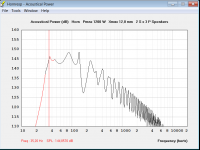Right. So it's an interesting piece of technical information and can be useful for determining where the system is most efficient, but it's not helpful for specifying amp power or finding the power capacity of that speaker (or you might think "better not use more than a 200w amp!")
Yea that sounds about right. I should have said a lot of power or a large stack. You could EQ up the lower registers when using two of them, in a pinch.My experience is that FLHs don't need a lot of power, but you absolutely need a stack.
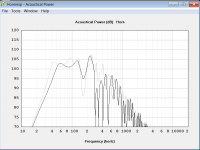
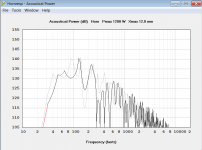
Here is a simple comparison with the Fane Colossus Prime 18XS in a THAM18 and a ROAR18.
The ROAR18 has much more usable output in the midbass (75 - 110 Hz with +10 dB at 95 Hz) and almost 10 Hz more low end. It is a much larger box to build, but the consistent use of 90 degree corners makes for a very easy build.
Cheers,
Johannes
Last edited:
Hemi, my reaction was for Grimmer, when he freaked out about how Fane exceeds its Xmax at 200W, and you kinda supported him with a claim that he must have done something wrong. Wanted to correct this one.
No. That is normal, and no, he deidn ´t do anything wrong. Even larger rivers will exceed its excursion capabilities with 200W normally, at certain frequencies.
I wasn´t really pointing at efficiency thingie when I picked this topic up again. It´s just so connected hand-in hand, that it gets discussed from many angles, and for many reasons. Usable or recommended power input could be another one.
No. That is normal, and no, he deidn ´t do anything wrong. Even larger rivers will exceed its excursion capabilities with 200W normally, at certain frequencies.
I wasn´t really pointing at efficiency thingie when I picked this topic up again. It´s just so connected hand-in hand, that it gets discussed from many angles, and for many reasons. Usable or recommended power input could be another one.
Another advantage we have found with the ROAR series over the THAM series is that the front-resonator has a much larger bandwidth compared to the single peak of the mouth-tap on a tapped horn like the THAM. This makes the ROAR sound much more similar to a FLH in the midbass. It has a much more pronounced physical hard "knock" then most tapped horns. The hard knock and great midbass punch is a very addictive character normally only found in good front loaded horns. I don't want to claim that it is as good as a true FLH but it has a lot of the same character.
Cheers,
Johannes
Cheers,
Johannes
Damn, Circlomanen you really bug me with this. 
I´m in the situation of wanting to build herd of compact 12" bass bins, and what you write is "sweet music" on my ears. Only if thrre was some extended version of Roar12, gong down to 33-34Hz, and down to 30Hz in stack of six...
I´m in the situation of wanting to build herd of compact 12" bass bins, and what you write is "sweet music" on my ears. Only if thrre was some extended version of Roar12, gong down to 33-34Hz, and down to 30Hz in stack of six...
Dimensions and weight, that´s the problem! I need small, almost "one handed handling" boxes (not really) which go down to 30-ish, and get the needed SPL by quantity.
Currently, bassreflex still wins. Maybe TL.
A 12inch will hit xmax in no time at such low frequencies
Errr, well yes, but not exactly:
1) When you tune it there, there will propably be excursion minimum.
2) That´s where stacks come into play. I plan to get at least 8 of these if all goes well. That will make cone area of at least 3840sq cm.
That´s cone area larger than 2x 21”. Then, it certainly will not hit xmax faster than one 18”.
So It will be mobile, and it I won´t hesitate to chuck one or two in my car and go for small grill party, or pack everything, and feed 250 people with it.
With 21”s (I have one) it´s a nightmare to get it to the car by me alone.
1) When you tune it there, there will propably be excursion minimum.
2) That´s where stacks come into play. I plan to get at least 8 of these if all goes well. That will make cone area of at least 3840sq cm.
That´s cone area larger than 2x 21”. Then, it certainly will not hit xmax faster than one 18”.
So It will be mobile, and it I won´t hesitate to chuck one or two in my car and go for small grill party, or pack everything, and feed 250 people with it.
With 21”s (I have one) it´s a nightmare to get it to the car by me alone.
Gaawwwd. That Roar18 just caught my attention now. They're just a lot bigger. My question is now. Do I need 30-40hz? They're mainly for EDM music. Hard-dance,Trap and even 80s disco occasionally. They might also be used for live music. What do you reckon?
Both in and outdoor
Both in and outdoor
If you haven't bought any drivers yet, then there is always the ROAR15.
A ROAR15 with a B&C 15TBW100 is a quite capable beast. They are a little more manageable and will give you a solid 40 Hz response.
My ROAR12 feels a little thin in the deep bass below 40 Hz, and even more so with EDM.
I guess the ROAR18 would be more suitable if you primarily play EDM. It will have a whole other weight and power for modern EDM and stuff like dubstep.etc.
Martinsson's Blog - ROAR15
Cheers,
Johannes
A ROAR15 with a B&C 15TBW100 is a quite capable beast. They are a little more manageable and will give you a solid 40 Hz response.
My ROAR12 feels a little thin in the deep bass below 40 Hz, and even more so with EDM.
I guess the ROAR18 would be more suitable if you primarily play EDM. It will have a whole other weight and power for modern EDM and stuff like dubstep.etc.
Martinsson's Blog - ROAR15
Cheers,
Johannes
If you haven't bought any drivers yet, then there is always the ROAR15.
A ROAR15 with a B&C 15TBW100 is a quite capable beast. They are a little more manageable and will give you a solid 40 Hz response.
My ROAR12 feels a little thin in the deep bass below 40 Hz, and even more so with EDM.
I guess the ROAR18 would be more suitable if you primarily play EDM. It will have a whole other weight and power for modern EDM and stuff like dubstep.etc.
Martinsson's Blog - ROAR15
Cheers,
Johannes
Still very big. 17 cm deeper
And the response will not be as great.
What are the general pros / cons for the Tham and Roar? I am tempted to build 6 Tham and then just build 2 Roar for fun
What are the general pros / cons for the Tham and Roar?
THAM:
+Lighter weight due to less internal walls.
+Proven design.
+A more "happy" sound - not as physical and brutal.
-Less output in the midbass.
-Not a symmetrical load on the driver.
-Less downward extension (higher tuning).
ROAR:
+Symmetrical and very even loading of the driver cone.
+More downward extension.
+More midbass.
+Great midbass punch.
+More real life output due to a better symmetrical loading, very high efficiency in the very energy-dense midbass and less turbulence in the tapped pipe section at high powerlevels.
+Very robust construction.
+Easy to build - only straight 90 degree cuts.
+Very easy bracing due to straight constant area sections.
-Heavy due to the split path design.
-My ROAR has a very physical and tactile character. It has a knack for making everything rattle and buzz, even at quite low levels. This is not always a downside. It can be quite fun and very entertaining, but it can also make you feel nauseous after a while. I don't experience this with the THAM series.
-Large and awkward to handle.
-Mounting or removing the driver can be challenging due to the deep front resonator.
Regards,
Johannes
THAM:
+Lighter weight due to less internal walls.
+Proven design.
+A more "happy" sound - not as physical and brutal.
-Less output in the midbass.
-Not a symmetrical load on the driver.
-Less downward extension (higher tuning).
ROAR:
+Symmetrical and very even loading of the driver cone.
+More downward extension.
+More midbass.
+Great midbass punch.
+More real life output due to a better symmetrical loading, very high efficiency in the very energy-dense midbass and less turbulence in the tapped pipe section at high powerlevels.
+Very robust construction.
+Easy to build - only straight 90 degree cuts.
+Very easy bracing due to straight constant area sections.
-Heavy due to the split path design.
-My ROAR has a very physical and tactile character. It has a knack for making everything rattle and buzz, even at quite low levels. This is not always a downside. It can be quite fun and very entertaining, but it can also make you feel nauseous after a while. I don't experience this with the THAM series.
-Large and awkward to handle.
-Mounting or removing the driver can be challenging due to the deep front resonator.
Regards,
Johannes
Thank you very much. But I guess when comparing a single Roar12 (underlining 12) against 4-6 Tham18, then the stack would ultimately get the same tuning as the Roar12.
Some guy on youtube showed off his Tham18 and Cubo18 (Looks like the Cubo sub though) and according to him he found the Cubo to play lower. I might actually make him do the decision.
although the Roar looks amazing, I might do it as a later project. I can always just build a cab and then swap drivers around. The Fane 18XS seems like a bad *** driver. Another problem might be that the tuning is crazy low when stack multiple Roar18 cabs
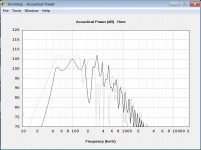
But I guess when comparing a single Roar12 (underlining 12) against 4-6 Tham18, then the stack would ultimately get the same tuning as the Roar12.
4 THAM18 with the Fane Colossus driver (grey line) compared to one single ROAR12 with a B&C 12PS100. All drivers get 2,83 volt.
One ROAR18 will go almost 10 Hz lower then 4 THAM18.
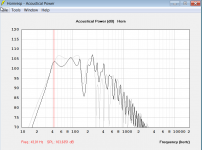
Black line is a single ROAR18 and the gray line is a stack of 4 THAM18.
Cheers,
Johannes
Last edited:
Another problem might be that the tuning is crazy low when stack multiple Roar18 cabs
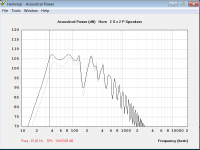
One vs four ROAR18 with the Fane driver.
A stack of four ROAR18 will have the middle of the lower peak at 39 Hz and a single ROAR18 at 44 Hz.
The ROAR series is not as proven yet as the THAM. If you feel hesitant I would recommend you to go with a proven design. ROAR is currently for the brave who wants to test something new. I am very impressed by my ROAR12. It is a very capable and fun design.
Cheers,
Johannes
Hi Grymer,
Nicholai, when a driver looks nice in a TH sim it doesn't necessarily mean it will work as well in the real world. If you use a less suitable TH driver the efficiency at the 1/4WL system resonance of the TH will be lower in the real world. Worse, it might 'push' the roll-off upwards in frequency (up to 10Hz is not unusual) or the driver might run into serious nonlinear behaviour before Xmax is reached.
The motor of the driver needs to be strong enough and suspension stiff enough (in relation to its mass) to deal with the acoustical impedance peak of a tapped horn, at its 1/4WL system resonance.
A few indicators to make it easier to search for the TH-compatible 18" drivers, Rme above 125 N*s/m and Vas below 230 liter (for a typical 18” loaded TH with medium to low compression ratio and a system resonance roughly between 35 to 40Hz).
Rme = (BL*BL)/Re = Electromagnetic damping (in N*s/m or Kg/s) and can be used to indicate motor power.
An example of an economic (230€ EU) ferrite-driver is the Oberton 18XB700 and seems to get very good responses from TH users. Xmax is 9mm, Rme = 131,8 N*s/m, Vas = 183,22 L
An example of an economic (304€ EU) neo-driver is the RCF LF18N40, Xmax = 14,2mm, Rme = 145 N*s/m, Vas = 227 L
Regards,
Djim
Nicholai, when a driver looks nice in a TH sim it doesn't necessarily mean it will work as well in the real world. If you use a less suitable TH driver the efficiency at the 1/4WL system resonance of the TH will be lower in the real world. Worse, it might 'push' the roll-off upwards in frequency (up to 10Hz is not unusual) or the driver might run into serious nonlinear behaviour before Xmax is reached.
The motor of the driver needs to be strong enough and suspension stiff enough (in relation to its mass) to deal with the acoustical impedance peak of a tapped horn, at its 1/4WL system resonance.
A few indicators to make it easier to search for the TH-compatible 18" drivers, Rme above 125 N*s/m and Vas below 230 liter (for a typical 18” loaded TH with medium to low compression ratio and a system resonance roughly between 35 to 40Hz).
Rme = (BL*BL)/Re = Electromagnetic damping (in N*s/m or Kg/s) and can be used to indicate motor power.
An example of an economic (230€ EU) ferrite-driver is the Oberton 18XB700 and seems to get very good responses from TH users. Xmax is 9mm, Rme = 131,8 N*s/m, Vas = 183,22 L
An example of an economic (304€ EU) neo-driver is the RCF LF18N40, Xmax = 14,2mm, Rme = 145 N*s/m, Vas = 227 L
Regards,
Djim
Last edited:
Most of the simulations I run with drivers which look like they might not be best suited for tapped horns tend to exhibit many of these behaviours already in the simulations - the 10Hz higher cutoff, and the reaching of excursion limits much faster than usual. Lower efficiency is less clear but certainly if averaged across the typical passband, the efficiency would be lower.If you use a less suitable TH driver the efficiency at the 1/4WL system resonance of the TH will be lower in the real world. Worse, it might 'push' the roll-off upwards in frequency (up to 10Hz is not unusual) or the driver might run into serious nonlinear behaviour before Xmax is reached.
(The Faital 18FH500 for example, is about 10Hz higher in f3 than other drivers in the THAM18, and reaches xmax with very little power input)
It has 375 Vas and 19 BL. Rme = 70.
But the simulations for this driver seem to bear out much of the content of your warnings already. Do you have good reason to suggest Hornresp is failing to accurately sim 'unsuitable' drivers?
Anecdotally, many people have also reported favourable results with the Eminence Kappalite 3015LF, which scores appallingly with your rule of thumb (Rme = 52.5) Vas is 150 litres which is a bit better but if we approximate those scores up for an 18" equivalent, it's still ~75 Rme and 215 litres or so. Not quite as far out as the 18FH500 but still way off your suggestion.
Edit: As an example of how Hornresp already makes 'unsuitable' drivers look pretty unappealing in the sims, here's the Kappalite 3015LF modelled in a THAM15
The 18FH500 is a similar story, although personally I quite like the curve it displays in the THAM18 and it seems a viable candidate if you're happy with the limitations it presents. (with the advantages as I see them being: 9.25mm xmax, 4.6kg weight, reasonable price, and the response appears suited to the THAM18 provided your biggest priorities are to get the cone moving with very little power, and lightest possible weight of enclosure. Which are basically low powered 12v specific requirements, fully off-grid high efficiency lightweight solar power systems ie - in which case rolling of the bass between 50-60Hz is normal anyway)
Unless the sims really are failing to tell the story which I don't doubt is possible.
Last edited:
Hi Hemisphere,
Hornresp only calculates with small signal parameters. Large signal measurements include electrical, mechanical and acoustical losses that do not play a role in simulations, so I don't see why this must be blamed on a failing Hornresp?
Rough 'indicators' can be useful in preventing unexpected results. But if you take the 'indicators' out of their context by changing the conditions like a smaller driver, higher system tuning, they are no longer valid. In quite some threads you can find more info and discussion on this subject that might be interesting for you to look at.
I can also recommend to read everything from Danley about what makes an 'ideal' TH driver, although, it is sometimes difficult to trace on the internet, after so many years.
Regards,
Djim
Hornresp only calculates with small signal parameters. Large signal measurements include electrical, mechanical and acoustical losses that do not play a role in simulations, so I don't see why this must be blamed on a failing Hornresp?
Rough 'indicators' can be useful in preventing unexpected results. But if you take the 'indicators' out of their context by changing the conditions like a smaller driver, higher system tuning, they are no longer valid. In quite some threads you can find more info and discussion on this subject that might be interesting for you to look at.
I can also recommend to read everything from Danley about what makes an 'ideal' TH driver, although, it is sometimes difficult to trace on the internet, after so many years.
Regards,
Djim
- Status
- This old topic is closed. If you want to reopen this topic, contact a moderator using the "Report Post" button.
- Home
- Loudspeakers
- Subwoofers
- Fane Colossus Prime 18XS experience?
